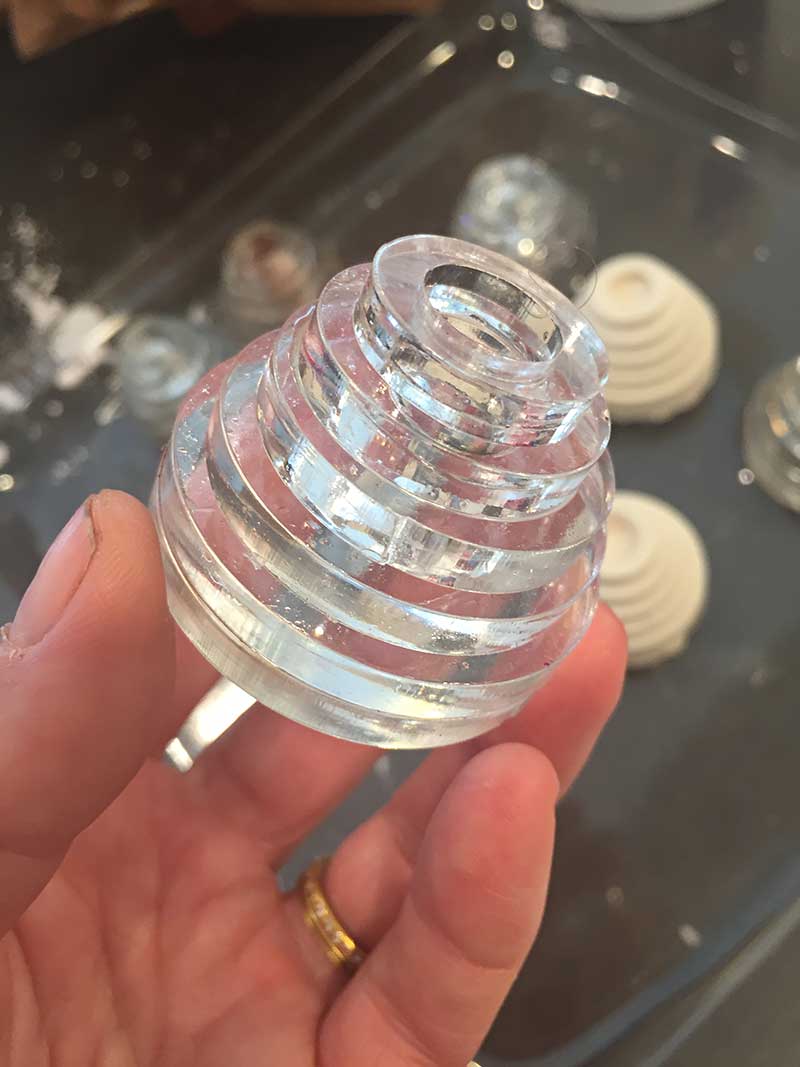Using Blender to model and Pepakura to produce paper patterns for tree branches.
open studio
Trump and Putin /
With the news blowing up about election interference, I can't resist reposting these paintings from last year: "Donald Trump (The Big Hack)" and "Vladimir Putin (The Operational Amplifier)." Politics, technology, gobbledygook, obfuscation, and sneakiness. Oil on canvas, 2017
Piezo speaker housing /
Here's a prototype of a housing for a piezo speaker that I will actuate with analog electronic insect sounds. The shape of the housing and mechanical pressure on the piezo element will change the pitch as well as the volume. I made this housing by first laser cutting 1/4" acrylic and gluing the stacked rings to make a pyramidal-shaped buck — see images below. Note that there's a central hole all the way through the buck to aid the vacuum forming process. I’ve vacuum-formed .080” and .090" acrylic sheet over the buck (both work fine) and used a laser to cut the shapes out. My registration needs improvement, but you get the idea. The piezo element is mounted inside of the housing by a short length of plastic tube that I glued in place.
Below I show my process to cast the acrylic buck in plaster (using an alginate mold). I will use plaster, wood, or metal bucks in the future because acrylic deforms in the vacuum forming process. In either case, it is critical to use mold release.
Why am I doing this? Because when RadioShack went out of business, I could no longer buy the piezo speakers that I used for my insect sounds. I was forced to reverse engineer the part --which turned out to be a blessing because the sound of insects is heavily dependent upon the mechanics of speaker design (not just the electronics which drive the speaker). For a previous blog entry on this issue, link here or read about my project “Hacking Nature’s Musicians” on Hackaday.io
Chicken slaughter /
Yesterday, fifteen of our chickens were slaughtered while I was away. I found piles of feathers all through the fields and two dead bodies but the rest were gone. A pack of coyotes must have attacked around the same time that an intense thunderstorm left things looking like a demon ripped through. Something turned the water in my fountain freakishly red. I found a few survivors, wet as rats, babbling anxiously as they wandered the fence line. Young chickens are so bright, curious and love to explore - it’s sad to see them lose their innocence to the inevitable predatory attack.
Pretty computer accidents /
Pretty computer accidents. I continue to work on a labor-intensive sculpture (electrolier). This video is tangentially related, insofar as I've discovered some cool visuals along the way. It would take me a long time to explain the sequence of computer accidents that created this landscape. Suffice it to say that the cloud and the mountainous earth are two different spatial interpretations of the same object, which in engineering terms means that the algorithm was an explosive failure. "Pretty is as pretty does" is not true in this case.
Artifacts /
Artifacts of a tedious creative process, incidentally piling up beside a childhood photo. July 2018
Animating butterflies /
Lately, I've been inspired by the little white butterflies flitting around my garden. I used analog electronics and LEDs to animate their flutter patterns. My circuit contains one master 555 timer / 4017 counter that sequences three butterfly (or moth) circuits. The individuals also have 555 timer / 4017 counter circuits that flash their LEDs in rapid sequence. I used transistor inverters on the master circuit to convert the active high logic of the 4017 to active low; and I connected these signals to clock enable (pin 13) of the 4017s on each of the butterflies. That's what causes their blinking to pause periodically. The random appearance of the blinking is thanks to capacitive coupling between signal lines, and without this the "flutter" effect is pretty boring. In other words, nature contains both order and chaos, where the order is by design (who's design? I have no idea) and the chaos happens through simple, recursive relationships that get complex fast.
Electronic moth assembly /
Making moths at my bench (May, 2018). The wings are dyed velvet that I embroidered with an old CNC machine (a 1982 refurbished Ultramatic at NovaLabs in Reston, VA). The bodies are circuit boards that I designed involving timers, counters, and multivibrators to sequence a trail of LEDs. The legs and antenna are laser cut plastic. The LEDs are multiplexed on a flexible circuit board that I modeled after symbols in the ancient temples of Mitla. All of these boards were manufactured by PCBWay in China. These photos were taken at my studio in Virginia.





















